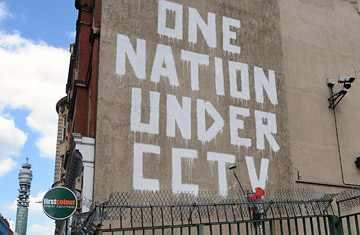
The artwork by graffiti artist 'Banksy' in the yard of a Royal Mail depot in central London, UK
Even though artwork by the British graffiti artist Banksy is popular with celebrities such as Angelina Jolie and Christina Aguilera, some regard the artist's street works to be vandalism, pure and simple. On Oct. 23, the Council of Westminster in London ordered the removal of a 23 ft (7 m) Banksy mural — reportedly his largest work in central London — claiming that it encourages graffiti.
In an exclusive statement to TIME, the mysterious guerrilla prankster has responded to the council's decision. "I don't know what next door is complaining about — their building is so ugly the 'No Trespassing' sign reads like an insult," the statement reads, referring to Royal Mail, a tenant of the building that has sought the mural's removal. In light of several other recent controversies over Banksy's outdoor works, this removal is further indication of the challenges that can arise when a famous artist uses private property as his canvas.
While Banksy made his name — or, rather, pseudonym — painting stenciled political and satirical images out-of-doors, in recent years his commercial pieces, including drawings, paintings and installations, have sold at auction for hundreds of thousands of dollars. At the same time, Banksy continues to create the street artwork he's famous for. The Westminster piece depicts a child in a red, hooded sweatshirt on a ladder painting the slogan "One Nation Under CCTV" in large letters, as a U.S.-style police officer with a camera and a dog stand nearby. CCTV is Britain's system of closed-circuit public surveillance cameras. Ironically, Banksy completed the work with an actual CCTV camera overhead.
There is currently a dispute over who owns the wall: Royal Mail, which wants the mural removed, or the property investment firm Searchgrade, which filed papers to keep the mural, claiming it's an advertisement, according to councilor David Boothroyd, who served on the planning committee that decided the mural should go. The council denied Searchgrade's request and is working to determine the wall's true owner. If it turns out to be Searchgrade, the company may appeal the decision and, ultimately, the mural could stay. Boothroyd guesses that the process will take a few more months.
Even if it would save the artwork, Banksy, forever the contrarian rebel, doesn't want his art classified as an advertisement, and in his statement says he was "offended" by the suggestion. "Advertising makes people feel inadequate and worthless. Graffiti doesn't do that. Graffiti doesn't emotionally blackmail you, graffiti doesn't make you feel fat and graffiti doesn't make you rush out and buy things — except maybe high-strength cleaning products," the statement reads.
If the work stays, there's a chance the wall's owners could profit in more ways than one. For starters, Banksy murals bring foot traffic. Crowds of admirers and photographers have invaded the Westminster block since the mural appeared in April. But not everyone likes the attention. According to Boothroyd, the crowds are Royal Mail's main complaint, as they block the mail vans from coming in and out of the parking lot.
Unlike most graffiti, Banksy's work, if it remains, is likely to add value to the property, not least because it's considered a valuable work of art. But attempting to sell Banksy's street works can be a risky business. Last month, five of the artist's street pieces failed to sell at auction because Banksy refused to verify their authenticity. In January, a wall Banksy painted received a final bid of over $400,000 in an eBay auction, but the sale was never finalized, according to Banksy's publicist. The organization that authenticates Banksy's artwork, Pest Control, refuses to approve street pieces because the artist prefers the work to remain in situ and "building owners tend to become irate when their doors go missing because of a stencil," the group's website states. Acoris Andipa, owner and director of the Andipa Gallery in London, which has sold Banksy's work, says that any "intelligent buyer" would not entertain the possibility of purchasing one of Banksy's street pieces. "It comes with too many question marks and a clear message from the artist that these works are not to be sold," he says.
This isn't the first time a council has taken a pass on Banksy. In Oct. 2007, the London council of Tower Hamlets ordered the removal of his work. A year earlier, the city council of Bristol, reportedly Banksy's hometown, had considered removing one of his murals, but in the end allowed it to remain, citing an outpouring of public support on an online forum.
Despite sometimes losing his work to whitewash or a power hose, Banksy's career seems to be continuing on its upward trajectory. His latest work is an installation called "The Village Pet Store and Charcoal Grill," a commentary on the human-animal relationship that features walking chicken nuggets, swimming fish sticks and hot dogs that slither like snakes. It has been captivating the New York City art scene this month and closes Oct. 31. Although he works undercover, it doesn't look like Banksy can escape the spotlight.
